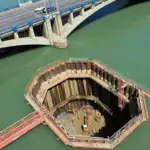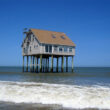The propellers of large ships, such as container carriers, tankers, and cruise ships, are remarkable feats of engineering that play a crucial role in ensuring efficient propulsion. These massive components, with diameters ranging from 6 to 10 meters and weights of 70 to 130 tons, are essential for the smooth operation of these enormous vessels. For instance, the propeller of the famous Emma Maersk measures an impressive 9.6 meters in diameter and weighs 131 tons, reflecting the scale of such maritime innovations.

Material Excellence for Durability
To withstand the harsh marine environment and the enormous stresses of operation, ship propellers are constructed using nickel-aluminum-bronze alloys. These materials are chosen for their exceptional durability, corrosion resistance, and strength, ensuring reliable performance even under the most demanding conditions.
Designing for Optimal Performance
Most large ship propellers have 4 to 6 blades, each crafted with a hydrodynamic design. The shape and contour of these blades are meticulously optimized using advanced computational fluid dynamics (CFD) simulations. CFD helps engineers analyze and refine the design to minimize cavitation—a phenomenon where vapor bubbles form on the blade surfaces due to pressure differences. By reducing cavitation, propellers maintain efficiency, reduce noise, and prevent damage to the blades.
Precision in Manufacturing
The manufacturing process of ship propellers is an intricate combination of technology and craftsmanship. Precision casting is the primary method used, ensuring that the propeller blades are uniform and free of defects. After casting, the propellers undergo rigorous quality inspections, including non-destructive testing methods, to verify their structural integrity and performance capability.
Impressive Operational Capabilities
Despite their massive size and weight, these propellers rotate at relatively low speeds, typically between 60 and 100 revolutions per minute (RPM). However, their slow rotation does not hinder their performance. They generate hundreds of tons of thrust, which is necessary to propel ships weighing thousands of tons through oceans and seas efficiently. For example, the Queen Mary 2 is powered by four propellers, each 6.6 feet in diameter and weighing 32 tons, collectively providing the thrust needed for its voyages.
Pioneering the Future of Maritime Propulsion
Large ship propellers exemplify the fusion of advanced engineering, cutting-edge technology, and meticulous craftsmanship. Their hydrodynamic efficiency and robust construction not only enable the movement of massive vessels but also ensure energy-efficient operations, contributing to the sustainability of maritime transportation. As the shipping industry evolves, further advancements in materials and design are anticipated, paving the way for even more efficient and environmentally friendly propulsion systems.
A Testament to Human Ingenuity
The sheer scale and complexity of large ship propellers underscore humanity’s capacity to conquer engineering challenges. Whether it’s a container ship crossing the oceans or a luxurious cruise liner navigating scenic routes, these engineering marvels ensure that global maritime operations continue seamlessly.




















